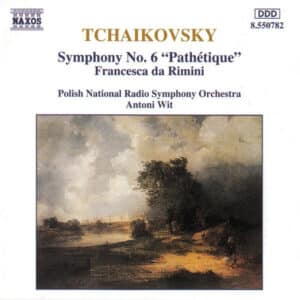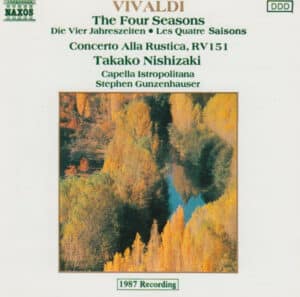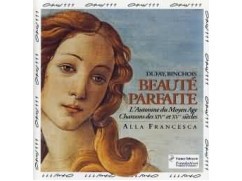Alla Francesca – Beaute Parfaite (CD)
Mpl
1 Beaute Parfaite 0:02:53 Anthonello Da Caserta – Bonte Soverayne, Ballade For 3 Voices
2 Pour Vous Servir 0:02:15 Anonymous, French
3 Par Maintes Fois 0:02:48 Jehan Vaillant – Virelai
4 Fumeux Fume Par Fumee 0:07:41 Solage – Rondeau For 3 Voices
5 Saves Pour Quoy Suy Sy Gay 0:01:40 Raulin De Vaux
6 Entre Vous, Nouviaux Maries 0:02:03 Johannes Le Grant – Ballade
7 J’aim. Qui? Vous. Moy? 0:02:06 Mahieu Paullet
8 Or Sus, Vous Dormes Trop 0:03:49 Anonymus
9 Tousjours Servir Je Veuil 0:03:01 Anonymus – Rondeau
10 Se Je Me Plains 0:05:00 Gautier Libert – Rondeau
11 Pastourelle En Un Vergier 0:01:55 Pierre Fontaine
12 Tant Qu’en Mon Cuer / Sur L’erbette 0:03:25 Anonymus
13 Or Sus Mon Coeur 0:02:52 Anonymus
14 Cheulz Qui Volent Retourner 0:02:43 Anonymus
15 La Belle Et La Gente Rose 0:02:09 Anonymous, Cyprus Manuscript
16 Quant La Doulce Jouvencelle 0:04:27 Anonymous, French – Chanson
17 Adieu, Jusques Je Vous Revoye 0:03:55 Gilles De Bins Dit Binchois – Rondeau For 3 Voices, R. 2
18 La Plus Jolie Et La Plus Belle 0:02:17 Nicolas Grenon
19 J’ai Mis Mon Cuer Et Ma Pensee 0:01:19 Gillaume Dufay – Ballade For 3 Voices
20 Ay, Douloureux Disant Helas 0:07:04 Gilles Binchois – Rondeau For 3 Voices, R. 9
21 Piece Instrumental 0:01:10 Anonymous, Manuscript D’Oxford
22 Je Vous Pri / Ma Tres Douce Amie / Tant Que Mon Argent Dura 0:01:38 Gillaume Dufay – Chanson For 4 Voices
At The Very Heart of the Hundred Years War (1336-1475), there occurred a truce lasting for thirty-five years (1380-1415) during which the French aristocracy forgot about their . endemic conflict with England and their own political and military weaknesses. The wealth deployed by the Valois – first amongst them being the young Charles VI, but also his brother, Louis of Orleans, and their uncles, the dukes of Bourbon, Berry and Burgundy – drew to Paris leading figures in all branches of the arts. There was much contact with the courts of the two rival popes in Avignon and in the north of Italy (this was the time of the Great Western Schism, which was soon to be resolved by the Council of Constance), and the influence of the Angevin Lusignan dynasty was such that the spread of French culture reached as far as Cyprus.
The composers of what is now known as the Ars subtilior (‘more subtle art’) took to extreme lengths the compositional procedures invented at the beginning of the fourteenth century by the theoreticians of the Ars nova. Rhythms became increasingly complex and melodic lines gained greater independence from each other in the overall polyphonic structure. The Italian Anthonello de Caserta, who composed several French songs, adopted this refined musical language. He paid homage to the illustrious French poet and musician, Guillaume de Machaut (c 1300-1377), setting to music one a ballad of his, Beaute parfaite.
In Paris, the mannerisms of the new style took other forms. Jean Vaillant (active between 1360 and 1390) and Solage (active between 1370 and 1390) enjoyed a close relationship with the sumptuous court of Duke Jean de Berry (1340-1416), and also ran a music school. A century before Janequin, Vaillant’s famous virelai Par maintes fois imitates birdsong with much use of onomatopoeia and evocative intervals. The same procedure, which is highly picturesque and redolent of folk music, appears in the anonymous piece, Or sus vous dormes trop. On the other hand, there is no such sound-painting to be found in Solage’s rondeau, Fumeux fume. It would appear that the piece was composed for the Parisian literary coterie whose members were known as the ‘Fumeux’, i.e. Originals, or Eccentrics, and which was presided over by the poet Eustache Deschamps (c 1346-c 1406), a disciple of Machaut. The low tessitura of the piece is most striking, as is its strange chromaticism, which echoes the obscure nature of the text.
The renewal of hostilities came as a sudden and brutal shock. The French aristocracy sustained catastrophic losses in the battle of Agincourt in 1415. Royal power began to totter: the Dauphin Charles was disinherited on the death of Charles VI in 1422, and an English lord, the Duke of Bedford, set himself up in Paris as regent in the name of the young king of England and France, Henry VI Plantagenet. Leading members of the nobility died, including the Duke of Berry in 1416 and above all Jean sans Peur, Duke of Burgundy, who was stabbed to death on the bridge at Montereau by supporters of the Dauphin.
As a consequence, Paris lost its supremacy in politics and the arts. The musicians left the city and took refuge either in the Duchy of Burgundy or in the Italian courts; the bond thus created between composers from the North and those from Italy was to last for well-nigh two centuries, until the twilight of the Renaissance. Pierre Fontaine (c1390-c1450), for example, entered the service of Jean sans Peur after having been cantor to the Duke of Berry at the Sainte-Chapelle in Bourges. After the assassination of the Duke of Burgundy, he went to the papal chapel which had been reorganised by Pope Martin V (1417-1431). Nicolas Grenon (c1380-1456), master of the boy-choristers in the great cathedral of Cambrai, joined him there in 1425. Guillaume Dufay (c1400-l474), who was also from Cambrai, and Gautier Libert took over from them in 1428. Whereas Grenon went back to his native country to end his days, as Dufay was to do later, Fontaine returned to the ducal chapel in Burgundy where a younger man, Gilles Binchois (c1400-1460), the faithful cantor of Philip the Good, officiated.
The ebb and flow of historical events was to speed up artistic evolution. Through their contact with the works of Italian and English composers, the Franco-Burgundian composers began to adopt new sounds, new forms and new musical practices. Towards 1420, they attempted to create a synthesis of these styles. The musical language of the Renaissance, the famous ‘Franco-Flemish counterpoint’, was coming into being.
While the Italian prelates and princes, anxious to enhance the prestige of their chapels, recruited Northern singers, copyists were devotedly collecting their compositions. The principal document is undoubtedly a Venetian manuscript, today referred to as Codex 213, in the Bodleian Library in Oxford. This is a monumental anthology containing 326 secular compositions, 235 of which are songs to French texts. It was compiled by a single scribe between 1426 and 1436 and provides invaluable insight into the diversity of styles cultivated during the early decades of the fifteenth century, and older composers like Fontaine and Grenon feature alongside their younger colleagues Dufay and Binchois. There are also works by Johannes Legrant, Paullet, Raulin de Vaux and Gautier Libert, about whom we know next to nothing; their total output is restricted to the very few attributions made by the scribe of this one manuscript.
The main activity of the cantors was the daily singing of the mass, though their duties might also include the composition of sacred works. Nevertheless, they were perfectly ready to compose polyphonic songs for the entertainment of their patrons. The aristocratic audiences were avid for variety, and French songs texts of popular inspiration are found side by side with declarations of ‘allegiance’ in true courtly love tradition. In one instance, Raulin de Vaux evokes the delights of the month of May (Saves pour quoy suy si gay?) ; in another, Johannes Legrant advises a newly-married couple not to fall asleep (Entre vous, nouviaux maries). Fontaine gives a new slant to the inexhaustible subject of the shepherdess and the knight with the courtly (or well-nigh so) remarks his Pastourelle utters. Finally, the anonymous composer of the drinking song Cheulx qui volent retourner reminds his companions from Picardy of the delights of the region around Laon and the village of Hasprois. These short songs are set to a homophonic (chordal) style of composition; the rhythms are sprightly and almost dance-like. Dufay adopted a very similar style in setting a highly courtly poem, the ballad Jay mis mon cuer et ma pensee. The diversity of the literary styles is matched by variety in the musical techniques used.
Imitative counterpoint was rare in the first half of the fifteenth century. As was the case in the fourteenth century, it usually appeared in the shape of canons for two or three voices at the same pitch (Tousjours servir). Gautier Libert shows some originality when he adds a free, non-contrapuntal third part to a fugal duet (Seje me plains). Paullet, in J’aim. Qui? Vous? Moi, his only known song, sets to music an amusing scene: the lovers’ dialogue is given to the top part, with the two lower voices echoing it verbatim.
In a great many polyphonic songs, the most important part is the top one, called the ‘cantus’. In Quant la doulce jouvencelle, for example, it is the only one which sings the text, and the other two parts have rather sober melodic lines – the monodic lyricism of the troubadours and the trouveres, whom Machaut was the last to champion, still lingers on. The counterpoint in Grenon’s La plus belle et doulce figure is more elaborate and the treatment of rhythm is more dense and varied.
For examples of perfectly balanced writing in this, the so-called ‘cantilena’ style, one must listen to Gilles Binchois, with his frequent use of thirds and sixths, which are sweet, consonant intervals. Even though his songs are models of the courtly style so much in favour at the Burgundian court, his unerring taste in poetry and his extraordinarily refined music keep his works well clear of cliches. Binchois was the composer who went the furthest in breathing lyrical vitality into the most conventional poetry; his sorrowful melodies convey the pain of separation with absolute sincerity. The originality of the two rondeaux, Adieu, jusques je vous revoye And Ay, douloureux, lies in their dark tessituras and atypical cadences; witness, for example, the falling third which Binchois uses in the cantus instead of the more commonplace rising second.
The recording ends with a song written to several texts, a genre which became very fashionable in the 1460s. Je vous pri / Ma tres douce amie / Tant que mon argent dura is a late work by Dufay; it is a setting for four voices of three completely different texts which are superimposed to delightfully ironic effect.
Anthonello Da Caserta (Composer)
Brigitte Lesne (Vocals, Harp)
Dominique Jullien (Flute)
Emmanuel Bonnardot (Vocals, Vihuela)
Florence Jacquemart (Flute)
Gautier Libert (Composer)
Gilles Binchois (Composer)
Guillaume Dufay (Composer)
Jehan Vaillant (Composer)
Johannes Le Grant (Composer)
Mahieu Paullet (Composer)
Marco Horvat (Vocals, Lute, Vihuela)
Pierre Fontaine (Composer)
Pierre Hamon (Flute)
Raphael Baoulay (Vocals)
Raulin De Vaux (Composer)
Bespaar portokosten bekijk ook mijn andere advertenties






